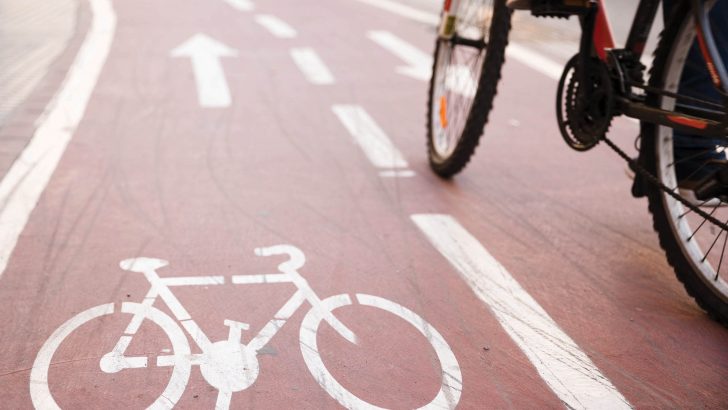Jason Osborne discusses the benefits of getting on your bike
With Ireland returning to ever-greater levels of normality despite the ongoing presence of the coronavirus, the issue of the daily commute is beginning to rear its head again, albeit in a different way.
With children and teenagers returning to schools and students preparing to return to colleges and universities, roads and public transport are once again beginning to fill.
While nowhere near their maximum capacity, parents and their children may be concerned about the safety of travelling by bus, train, or tram, while others may be troubled by the prospect of sitting in traffic once again.
There is an option that could kill both of these issues with one stone… hopping on a bike.
Cycling has enjoyed a surge of popularity in recent years, for a number of reasons. From its health benefits, to the negligible impact it has upon the environment, cycling has appeared to many as a quality alternative to the conventional modes of modern transport. So why not consider it?
Timing
The timing has never been better for swapping four wheels in favour of two, or busy roads for cycling lanes. As life slowly begins to get back underway, all the regular theatres of life are beginning to fill up again, insofar as they are able. Schools, shops, offices, restaurants and more, with universities and colleges sure to follow, are doing all they can to accommodate a gradual return to regular life – alongside the pandemic.
For families no longer confined to the home, the issue of how to travel to their respective workplaces is one that must be considered intently. For some, the fear of contracting the virus on public transport is real, with buses, trains, and trams having a concrete connection to the transmission of illness in normal conditions.
Families looking to avoid these settings on their way to well-prepared schools and workplaces ought to consider their bikes, now more than ever. If you are, how do you go about getting on the road safely?
Re-learning how to ride a bike
While it may be true that you never forget how to ride a bike, there certainly are aspects of cycling that require a brush-up.
Firstly, if you don’t have a bike, what kind of bike should you get? There are many different kinds of bike out there, more than ever before. A mountain bike worth thousands of euro won’t do you much good on your commute across the city, or along flat country lanes, so this question is of the utmost importance.
To answer this question, another one must be considered: Where do you want to go? If you’re going to be cycling along roads and desire comfort, then a hybrid bike with flat, straight handlebars and smooth wheels is probably the choice for you. If part of your journey is going to involve public transport, then a collapsible bike might be more suitable, if space is limited.
If time is of the essence in the mornings, a road bike or ‘racer’ might be the best option, with their narrow tires and curved, dropped handlebars offering less road and wind resistance, allowing for the highest speeds.
Or if you simply feel compelled to get into cycling for the thrill of it, or the exercise, a mountain bike will be one to consider, with its large, knobbly tires and generous suspension allowing for outlandish, off-road adventures.
These different types of bike make up a large portion of those seen out on the road, and each type has an endless variety of depth in terms of price, shape, colour, parts, and so on.
The array of options can appear daunting, but bike shops are generally manned by cyclists with many years of experience, so the best thing you can do is simply drop in and ask. They’ll be more than happy to help.
Now what?
Assuming you’ve bought your bike, the next step is to get road-ready. This is more than a matter of having a bike to ride. It’s a matter of having all of the measures in place to ensure your, or your children’s, safety.
You’ll need a helmet, perfectly fitted to your head, a high-visibility vest or jacket for the times you’ll be cycling in low-visibility conditions (or always if you prefer) and you’ll need lights for your bike, one going on the front and one on the back. You’ll also need to ensure that your bike is in good working order. It’s every cyclist’s nightmare to feel a wheel begin to wobble, or to find their breaks unresponsive as they speed down a hill!
Once safety is covered, matters of convenience ought to be attended to. Ireland is quite often a wet country, and there’s nothing worse than getting caught beneath a downpour on your way to work. Investing in a quality raincoat and over-trousers is worth every cyclist’s money, and you’ll get your use out of them here. Another defender against the rain is a mudguard, which is a thin piece of plastic positioned above your rear wheel, its purpose being to stop dirt, water, and mud from spattering your back as you travel.
Prepared for the rain, a pair of gloves or mitts is necessary for combatting the chill of the Irish winter. They also come in handy in the event of you coming off your bike, making your hands that bit less susceptible to cuts and scrapes.
Finally, a puncture repair kit is something every prospective cyclist ought to familiarise themselves with. All cyclists have been put out at least once in their lives by a puncture at a particularly inconvenient time. Having the kit is one thing, knowing how to use it is quite another. Fortunately, YouTube is awash with tutorials these days, and there are plenty of video tutorials to be found on there. If a video tutorial is of no interest, your local bike shop may be of use yet again, with experienced staff to hand for your questions and queries.
Ready to hit the road?
The last thing to do before undertaking a cycle to work or school is to familiarise yourself with the rules of the road from the cyclist’s perspective. How do you indicate on a bike? How do you cross the road at a junction? How do you conduct yourself on those occasions when you find cars pressing in on you from different directions?
A resource to help answer those questions is Cycle Right, which is the “National Standard for Cycle Training”, providing “practical cycle safety and skills training to promote competent and confident cyclists.” Found at cycleright.ie, this website is a go-to for rules of the road when it comes to cycling, for both adults and children.
The benefits
All of this preparation may seem off-putting, daunting even, but the benefits far outweigh the drawbacks.
Cycling has been shown to confer a plethora of health benefits, by multiple studies.
It has been shown to improve mental well-being, promote weight loss, build muscle, develop lung health (particularly important in light of the coronavirus), and cut heart disease and cancer risk.
As well as these positives, it is a particularly low-impact activity, which lowers your risk of injury. Unlike running, a weight-bearing form of exercise, cycling doesn’t involve jarring impacts beneath the load of your own body. Add that to the fact that it improves sleep, and cycling leaves you in good stead to go about the rest of your life well-rested and injury free.
Environmental benefits
The Church celebrates the Season of Creation from September 1 to October 4, which reminds us of our obligation as stewards of God’s creation. Cycling is a wonderful way to participate in the effort to care for the earth, with cycling:
- Contributing to diminishing fossil fuel usage
- Reducing air pollutants
- Reducing noise pollution and congestion
- Saving valuable green-space from development
With both the body and creation benefitting, the reasons to pick up a bike are numerous.
Enjoy
Cycling provides a welcome burst of fresh air first thing in the morning for those who opt to travel by bike to work, school, or college. With the pandemic still looming, it provides a welcome freedom where, for a long time, there’s been none. Take advantage of the ‘new normal’ by making it better than the old one.


 Ruadhán Jones
Ruadhán Jones
